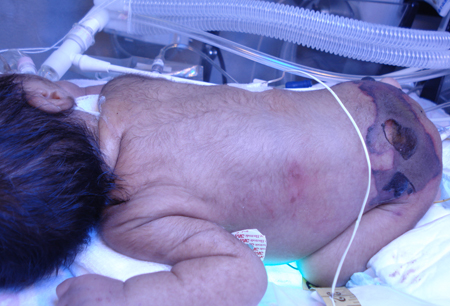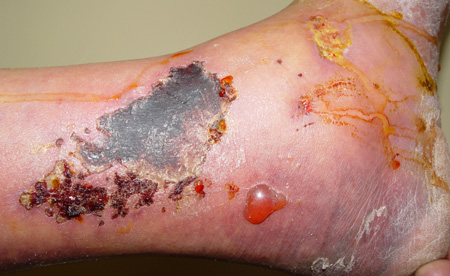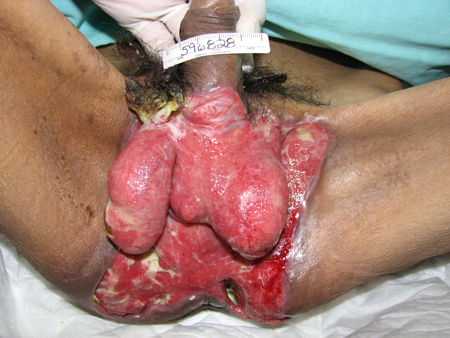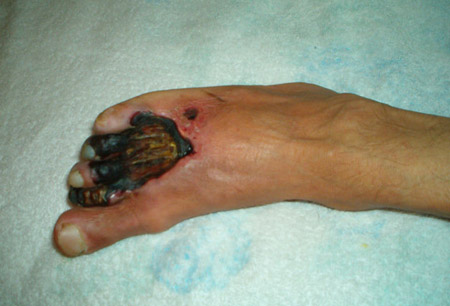History and exam
Key diagnostic factors
common
presence of risk factors
Major risk factors include: diabetes mellitus, atherosclerosis, smoking, hypercoagulable states, drug abuse, malignancy, renal disease, trauma or abdominal surgery, alcoholism, and malnutrition.
pain
Pain is often a feature of gangrene, although its absence does not exclude the diagnosis. There may be a history of chronic claudication-type pain in patients with ischaemic gangrene. By contrast, a sudden onset of pain is usually the first symptom of infectious gangrene. In addition, 50% of patients report a feeling of heaviness in the affected extremity.[43]
oedema or swelling
The affected region may become markedly oedematous, with overlying erythema.[43]
uncommon
skin discoloration
Ecchymoses, purpura, skin blebs, and haemorrhagic bullae may develop in gangrene.[43][Figure caption and citation for the preceding image starts]: Haemorrhagic blister formation secondary to ischaemic gangreneCollection of Jose Contreras-Ruiz (Clinica del Cuidado Integral de Heridas y Estomas) [Citation ends]. [Figure caption and citation for the preceding image starts]: Newborn with purpura fulminans due to Streptococcus B haemolyticusCollection of Jose Contreras-Ruiz (Clinica del Cuidado Integral de Heridas y Estomas) [Citation ends].
[Figure caption and citation for the preceding image starts]: Newborn with purpura fulminans due to Streptococcus B haemolyticusCollection of Jose Contreras-Ruiz (Clinica del Cuidado Integral de Heridas y Estomas) [Citation ends].
A black necrotic eschar may be evident at the borders of the affected areas. [Figure caption and citation for the preceding image starts]: Eschar surrounded by erythema, oedema, and haemorrhagic blistersCollection of Jose Contreras-Ruiz (Clinica del Cuidado Integral de Heridas y Estomas) [Citation ends]. [Figure caption and citation for the preceding image starts]: Eschar and blister formation with notable oedema in diabetic patient who developed gas gangrene after a lower limb traumaCollection of Jose Contreras-Ruiz (Clinica del Cuidado Integral de Heridas y Estomas) [Citation ends].
[Figure caption and citation for the preceding image starts]: Eschar and blister formation with notable oedema in diabetic patient who developed gas gangrene after a lower limb traumaCollection of Jose Contreras-Ruiz (Clinica del Cuidado Integral de Heridas y Estomas) [Citation ends].
crepitus (gas gangrene)
With gas gangrene, gentle palpation may demonstrate crepitus. It is found only in 14% of patients at presentation, but if present, some series have reported 99% specificity for gas gangrene.[43]
Other diagnostic factors
common
diminished pedal pulses and ankle-brachial index (ischaemic gangrene)
Suggests chronic arterial insufficiency. Erroneous ankle-brachial index readings can occur if there is calcification of arteries.
uncommon
low-grade fever and chills (infectious gangrene)
These may be early signs of infectious gangrene.
Risk factors
strong
diabetes mellitus
A particularly important risk factor because it is frequently associated with both ischaemic and infectious gangrene.[9] Infectious gangrene subtypes in patients with diabetes include non-clostridial anaerobic cellulitis, synergistic necrotising cellulitis, and type I necrotising fasciitis. High blood glucose levels, inefficient immunological responses, peripheral neuropathy, and peripheral arterial disease are the most important features of diabetes that contribute to limb-threatening diabetic foot infections.[24] Peripheral arterial disease (PAD) in patients with diabetes tends to involve smaller arteries and affects younger age group compared with non-diabetic patients.[25] The Framingham study showed that more than 50% of patients with diabetes have absent pedal pulses.[26] Nearly 70% of patients with necrotising fasciitis have diabetes.[5][Figure caption and citation for the preceding image starts]: Eschar and blister formation with notable oedema in diabetic patient who developed gas gangrene after a lower limb traumaCollection of Jose Contreras-Ruiz (Clinica del Cuidado Integral de Heridas y Estomas) [Citation ends].
atherosclerosis (ischaemic gangrene)
Atheromatous plaques contain a necrotic core within the arterial intima, consisting of foam cells, cellular debris, and lipids, covered by fibrous cap of endothelial cells. Spontaneous plaque rupture or shear forces of the circulating blood can disrupt this plaque, causing an atheroembolism that leads to tissue ischaemia and necrosis.[20]
smoking (ischaemic gangrene)
Tobacco smoking is directly related to vascular damage, contributing to chronic limb ischaemia. The presence of endothelial dysfunction is an early marker of vascular injury, predisposing to the development of atherosclerotic lesions.[27] Some studies have found a direct causal association between tobacco use and foot ulceration or amputation in patients with diabetes. A case-control study of people with diabetes in the UK found a lower risk of leg amputation in those of South Asian origin compared with those of European ancestry, which was partly attributed to lower rates of smoking.[28]
renal disease
Gangrene is a common complication in patients with end-stage renal disease, including kidney transplant recipients and those undergoing chronic peritoneal dialysis or haemodialysis. Patients often have evidence of secondary or tertiary hyperparathyroidism with an elevated serum calcium-phosphate product. Calciphylaxis may be unilateral or bilateral, and lesions may occur on the extremities, trunk, and buttocks. Lesions on the distal lower extremities may begin as livedo reticularis or acral cyanosis, but typically progress rapidly to ulceration and gangrene. Extreme cutaneous pain is common.[15][20]
drug and alcohol abuse
Cocaine causes intense vasoconstriction and also enhances platelet aggregation, placing users at risk of ischaemic gangrene.[11] Severe soft-tissue infections caused by Clostridium perfringens, C sordellii, and C novyi have been described among intradermal ('skin popping') and intravenous drug users.[29][30] Anaerobic infections occur at a much higher rate in drug users who inject. Accidental intra-arterial injection can cause arterial obstruction, leading to distal gangrene and amputation of fingers, toes, or even whole limbs.[31] These patients also often have impaired immunological response, due to habitual massive alcohol consumption and profound liver dysfunction.[32]
malignancy
A risk factor for both infective and ischaemic gangrene. Colorectal carcinoma is a common factor in spontaneous gas gangrene caused by Clostridium septicuminfection, which may progress to septicaemia.[18][33] Haematological malignancy and neutropenia are also associated with increased risk of infective gangrene.[1][23]
Malignancy is also a risk factor for ischaemic gangrene. Its association with Raynaud's phenomenon, acrocyanosis, and gangrene is called paraneoplastic acral vascular syndrome. About 60% of reported underlying malignancies are carcinomas of various histologies, most commonly adenocarcinomas (lung, ovaries, and stomach), and 20% are haematological malignancies.[20] The abnormalities in the skin appear simultaneously with cancer detection in about 50% of patients, precede the diagnosis in about 45%, and develop after the discovery of malignancy in about 5% of patients.[20] The most common skin finding is acute digital gangrene (in about 60% of cases), with the fingers being the affected site in 95% of patients.[20]
trauma or abdominal surgery (infectious gangrene)
Factors related to traumatic gas and infectious gangrene are bowel and biliary tract surgery, intramuscular injection of adrenaline (epinephrine), surgical closure of traumatic wounds, illegal or missed abortion, retained placenta, prolonged rupture of the membranes, and intrauterine fetal demise.
contaminated wounds (infectious gangrene)
Can predispose to the development of infectious gangrene. The initial lesion can arise after varicella or be trivial (e.g., insect bite, minor abrasion, injection site).[17]
weak
immunosuppression (infectious gangrene)
Immunosuppression due to malignancy and/or chemotherapy or radiotherapy, medications (especially chronic corticosteroid use), or infection (HIV) may predispose to soft-tissue infections. Immunosuppressed status may lead to a delay in diagnosis and surgical management, leading to greater risk of death.[34][35][36]
malnutrition (infectious gangrene)
Contributes to immunosuppression, and so is a risk factor for infectious gangrene, such as Fournier's gangrene.[37][Figure caption and citation for the preceding image starts]: Necrotising fasciitis I subtype involving genital and perineal region; image taken after extensive surgical debridementCollection of Jose Contreras-Ruiz (Clinica del Cuidado Integral de Heridas y Estomas) [Citation ends].
hypercoagulable states (ischaemic gangrene)
Can give rise to large thrombi, which can occlude prominent blood vessels and cause extensive ischaemic gangrene.[11][Figure caption and citation for the preceding image starts]: Ischaemic gangrene secondary to antiphospholipid syndromeCollection of Jose Contreras-Ruiz (Clinica del Cuidado Integral de Heridas y Estomas) [Citation ends].
prolonged application of tourniquets (ischaemic gangrene)
Can predispose to the development of ischaemic gangrene.
community-acquired MRSA
Risk factors associated with skin and soft tissue infections (SSTIs) caused by community-acquired MRSA include: age (children <2 years), contact sports, intravenous drug abuse, close skin-to-skin contact during homosexual male sex, military service, long stay in care facilities (correctional facilities, residential or nursing homes, and shelters), contact with livestock (vets, pet owners, and pig farmers), post-flu illness or severe pneumonia, concurrent SSTI, history of community-acquired MRSA colonisation, and a history of antibiotic use in the last year.[12]
Use of this content is subject to our disclaimer